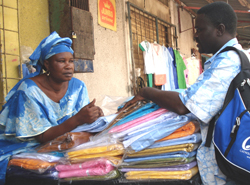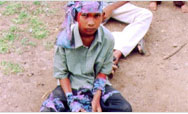You are here » Home » Telling Our Story
Success Story
Women find economic freedom and mobility through microfinance
Major Results from Women’s Microloans

Photo: Karen Cobos/CRS Senegal
Isseu Sambe (left) discusses her cloth business with André Youm at her market stall in Tivaoune, Senegal.
“As women, we find freedom in being able to earn our livelihoods and build for a future,” said Senegalese cloth vendor Isseu Sambe.
For too long, Senegalese cloth merchant Isseu Sambe saw her slim profits slip away as fast as they came in. Daily expenses quickly ate away earnings as she struggled to supplement her husband’s meager pension so that they could provide for their five children and six orphaned children from the extended family. She never imagined she would save over $800 until she learned about USAID-supported microfinance.
Isseu has been selling colorful, imported African cloth for eight years. In 2002, she tried out the Keur Khaly Village Bank in Tivaoune, operated by a local microfinance institution CAURIE-MF, and started saving a portion of her modest income. She began with a $60 loan to purchase cloth in bulk to increase her profit margin. By the close of the first six-month cycle, Isseu not only paid back the loan, but also managed to save $60 for herself. Since then, she has increased loans and repayment so that by the end of the fourth year, she had reached $1,000 of credit and $860 in savings.
Supported by USAID, CAURIE-MF transformed existing village banking microfinance activities into a formal microfinance institution. Operating through three branches nationwide, CAURIE-MF links credit with savings and seeks to assist poor women microentrepreneurs – typically traders, artisans, and farmers – who do not have access to financial services. The institution now reaches over 11,000 women through more than 200 village banks.
“Without the assistance of USAID, our microfinance activities would have had to stop, and the women would have returned to their prior state of poverty since they can not access credit through other financial institutions,” said André Youm, head of one of CAURIE-MF’s branches and the longest-serving member of the microfinance team.
Since she started saving, Isseu has bought bedroom furniture and a refrigerator for her home. Currently, she is working to build a new home on an old family plot. “Before, I never saved. Money was spent on small expenses. Now, I can save and spend on more important things,” she said.
Print-friendly version of this page (533kb - PDF)
Click here for high-res photo
Back to Top ^ | 

